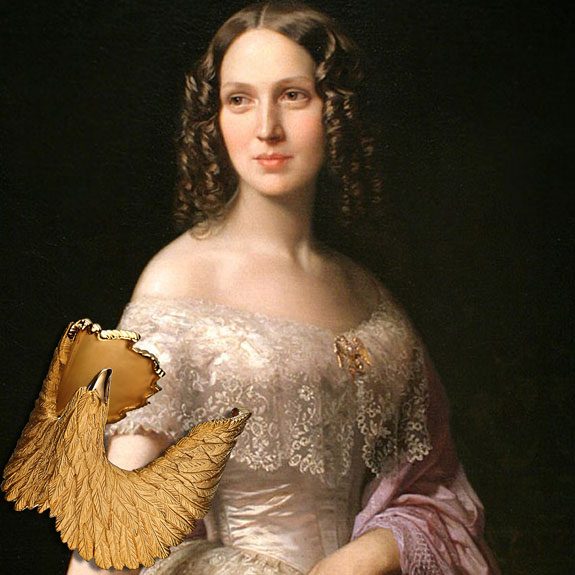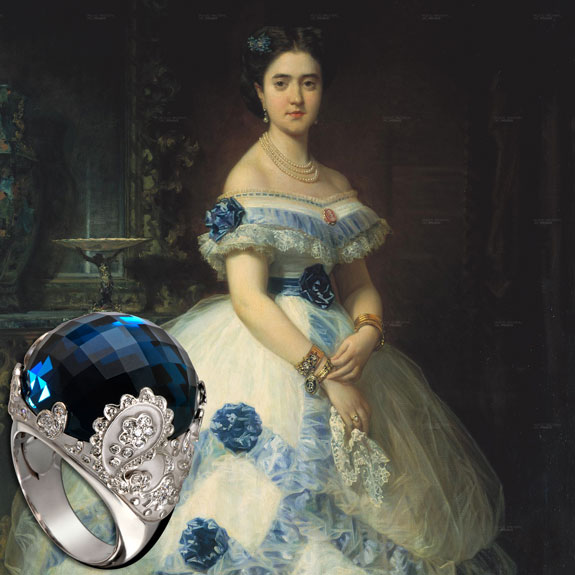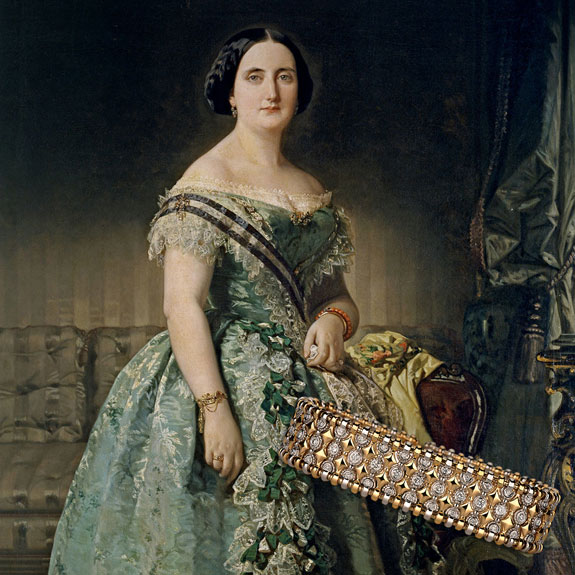Jewelry is a form of artistic expression, and Carrera y Carrera always bears this in mind. The Spanish painter Federico de Madrazo (1815-1984) devoted a special place to jewelry in his portraits. Sometime after Ferdinand VII began his reign, the imperial style of jewelry characteristic of the period gave way to a new style. A new artistic movement arose that focused on the jewel as a decorative element inspired by naturalism, supported by botanic collecting. This jewelry style, characterized by the profusion of flowers and petals, would be developed during the reign of Isabella II and is especially visible in the work of Federico de Madrazo.
At Carrera y Carrera, jewelry inspired by nature is part of many of its collections. As we review Madrazo’s work, we will incorporate pieces of the iconic Spanish jewelry brand into his portraits.
Federico de Madrazo, Amalia de Llano y Dotres, Countess of Vilches, 1853. Prado Museum, Madrid, Spain.
Federico de Madrazo: Queen Isabella II, 1850
Queen Isabella II was a great fan of the jewelry known during the period as “Isabelina”. It met the needs of the court and gentry who saw their social life thrive thanks to the proclamation of Princess Isabella as queen and the double wedding with her sister Luisa Fernanda.
The continuity of the governments of Narvaez and Bravo Murillo made social and recreational activities like parties, the theater, and celebrations as well as politicians, generals, and aristocrats (who had been exiled during the previous period) return to Spain, bringing with them the fashions and customs of Paris.
In this portrait by Federico de Madrazo, one may observe the profusion of jewels with pearls worn by Queen Isabella II. The Gardenias ring by Carrera y Carrera in yellow gold, diamonds, and pearl could have been part of this portrait.
Federico de Madrazo, Queen Isabella II, 1850. Ministry of Foreign Affairs, Rome, Italy.
Federico de Madrazo: Elizabeth Wethered Barringer, 1852
It is believed that Federico de Madrazo’s specialization in detailed painting of jewelry in his portraits could have been due to family influence. His father-in-law Rafael Garreta was a famous Madrid jeweler married to the daughter of a banker of Ferdinand VI. His jewelry shop was located on the Carrera de San Jerónimo. According to Raimundo de Madrazo, Federico’s son and also a painter, his grandparents owned such important pieces as the “La Peregrina pearl” which was one of the Spanish crown jewels, painted numerous times by Velázquez, and later belonging to the iconic Hollywood actress, Elizabeth Taylor.
Federico de Madrazo not only made portraits of Spanish royalty, but also painted foreign ladies like Elizabeth Wethered Barringer of England. In this case, the brooch worn in the painting is shaped like an eagle, something unusual in Spanish jewelry of the period. The inspiration may be related to naturalist representations and the creation of animal-shaped jewels in England such as dogs and horses.
The design of jewels with an animal theme has been a tradition at Carrera y Carrera from its inception. The Eagle bracelet in yellow gold belonging to the Bestiario collection perfectly illustrates this style.
Federico de Madrazo, Elizabeth Wethered Barringer, 1852. Ackland Art Museum, Chapel Hill, North Carolina, USA.
Federico de Madrazo: Concepción Remisa de Moret, 1856
Better than any of his contemporaries, Federico de Madrazo was able to capture in his portraits the glow of the noble atmosphere of that period in Madrid. He delighted all those who commissioned paintings thanks to his faithful and elegant representation of clothing and jewelry, through which these people flaunted their social status.
Concepción Remisa was the daughter of Gaspar de Remisa, one of the most important bankers in the Spain of Isabella II. She was married to the politician and literary figure Segismundo Moret, and chose the painter Federico de Madrazo to paint the couple portrait, so customary in the romantic world.
The Granada pendant from Carrera y Carrera in yellow gold and onyx could have been the perfect complement for the gold and pearl necklace and earring set that adorn Concepción’s charismatic face.
Federico de Madrazo, Concepción Remisa de Moret, 1856. Prado Museum, Madrid, Spain.
Federico de Madrazo: The Infanta Luisa Fernanda of Bourbon, 1851
The jewelry of the period centered on bracelets, rings, and brooches that were inspired by architectural patterns and figurative depictions of characters from medieval legends through mini sculptures. In the early years of this era, academic formalism continued, focusing on delicate leaves and flowers and on a figurative style faithful to reality. These naturalistic designs remained popular for over fifty years.
The Infanta Luisa Fernanda of Bourbon wears many jewels in this portrait: earrings, necklace, bracelet, diadem, and various brooches. All appear to be crafted in gold, diamonds, pearls, and rubies.
The Sol y Sombra earrings from Carrera y Carrera in white gold and diamonds possess that characteristic vintage flavor that makes them irresistible and completely a modern classic. The Infanta Luisa Fernanda of Bourbon surely would have worn them flawlessly in one of these portraits.
Federico de Madrazo, The Infanta Luisa Fernanda of Bourbon, 1851. Palacio Real, Madrid, Spain.
Federico de Madrazo: Isabel Álvarez Montes, 2nd Duchess of Castro Enríquez y 2nd Marchioness of Valdera, 1868
Federico de Madrazo’s specialty was courtly portraits in which the vestments of those being painted would be reflected in all of their splendor. The quality of the fabrics of the dresses, the accessories, as well as the jewelry played a very important role in these portraits.
Federico de Madrazo frequently made preparatory studies of the jewels he would portray in his paintings. In these studies, Madrazo noted how the jewels should be represented in the final portrait and added all types of details: the color of gold, the type of gem, and the reflections visible in the jewels…He tended to draw the jewels life-size in his portraits to be as close as possible to reality.
In this portrait of the Duchess of Castro Enríquez, she wears different jewels, several bracelets, and a triple-strand pearl necklace. As an accessory for her dress with blue details, the Aqua ring from Carrera y Carrera in white gold, diamonds, and faceted blue topaz could have been the ideal complement.
Federico de Madrazo: Isabel Álvarez Montes, 2nd Duchess of Castro Enríquez and 2nd Marchioness de Valdera, 1868. Prado Museum, Madrid, Spain.
Federico de Madrazo: Josefa Coello of Portugal, 1855
During this period it was customary for the portrait sitters to wear a single jewel. It was common that the only important jewel that adorned the immortalized woman would be a bracelet. The portrait of Mrs. Josefa Coello of Portugal is a clear example of this trend. It is a deceptively simple portrait that highlights the bracelet worn on her right arm. It depicts a boat with its sails unfurled and a fish hanging from the prow.
Creativity and imagination start to be present in the jewelry world. Figurative representations begin to be used in the jewels of the period. This is due to the need to bring dynamism to the jewels and to give them a much more decorative aspect than before.
One of the Carrera y Carrera jewels that Mrs. Josefa Coello of Portugal could have worn in this portrait is the Mosaicos bracelet, crafted in a beautiful combination of yellow and white gold with diamonds. A bracelet that supposes a declaration of intent.
Federico de Madrazo: Josefa Coello of Portugal, 1855. PradoMuseum, Madrid, España.
Source: La joyería romántica a través de los retratos de Federico de Madrazo, Amelia Aranda Huete














 No products in the cart.
No products in the cart.